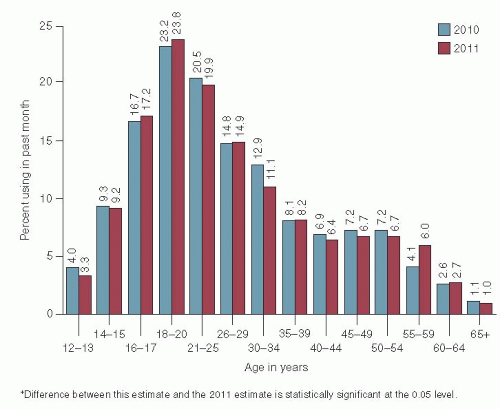The number of current methamphetamine users decreased between 2006 and 2010, from 731,000 (0.3%) to 353,000 (0.1%), but due to its potent addiction liability and destructive health and social consequences, it is still considered one of the most dangerous drugs of abuse.
Clinical Effects and Patterns of Abuse.
CNS stimulants are highly addictive substances that affect many organ systems. Cocaine’s effects appear almost immediately after a single dose and disappear within a few minutes to an hour. Cocaine initially constricts blood vessels, dilates pupils, and causes tachycardia, hypertension, fever, and tremor and produces euphoria, increased energy, and confidence followed by restlessness, anxiety, hostility, hypersexuality, and paranoia.
Prescription stimulants are abused to enhance performance and to get “high.” They can also be abused as a weight loss agent, to increase wakefulness, and to increase focus and attention. When abused, these medications are usually crushed and then snorted or injected. At low doses, it increases wakefulness and physical activity and causes euphoria and hypersexuality. At higher doses, it can cause anxiety, irritability, insomnia, and paranoia.
Due to longer duration of action, the clinical side effects of methamphetamine are related to its toxic effects on nerve terminals. Specifically chronic users of crystal meth develop psychotic symptoms, including paranoia, visual and auditory hallucinations, and delusions, sometimes irreversible changes in brain function and structure, memory loss, aggressive or violent behavior, and severe dental problems (“meth mouth”).
With chronic use resulting in dependence, patients with cocaine and stimulant use exhibit jitteriness, loss of appetite, weight loss, depression, a lack of energy, and malnourishment. Repeatedly snorting cocaine can cause loss of sense of smell, nosebleeds, swallowing problems, hoarseness, and irritation of the nasal septum.
Intravenous cocaine users are subject to developing infections, abscesses, and sepsis. They present with “track marks,” and IV users of cocaine are at increased risk for contracting infectious diseases such as human immunodeficiency virus (HIV) and viral hepatitis. This risk stems not only from sharing contaminated needles and drug paraphernalia but also from engaging in risky sexual behaviors as a result of intoxication.
Persons with stimulant dependence are at high risk for the development of a paranoid psychosis.
Withdrawal from cocaine is called “crash.” It is characterized by severe dysphoria, depression, anhedonia, fatigue, hypersomnia, and a craving for cocaine. Crystal meth and prescription stimulant withdrawal present similarly, and the long-term withdrawal symptoms can be significant and quite disabling. Patients present with anhedonia, hypersomnia, lack of energy and motivation, and inability to deal with demands of daily life routines.
Overdosing with cocaine or amphetamine produces tachyarrhythmias, perspiration or chills, nausea or vomiting, hypertension, high fever, seizures, delirium, paranoia, psychosis, coma, and cardiovascular collapse. Stroke and myocardial infarction have been reported with crack use. Cocaine-related deaths are often a result of cardiac arrest or seizures followed by respiratory arrest.











